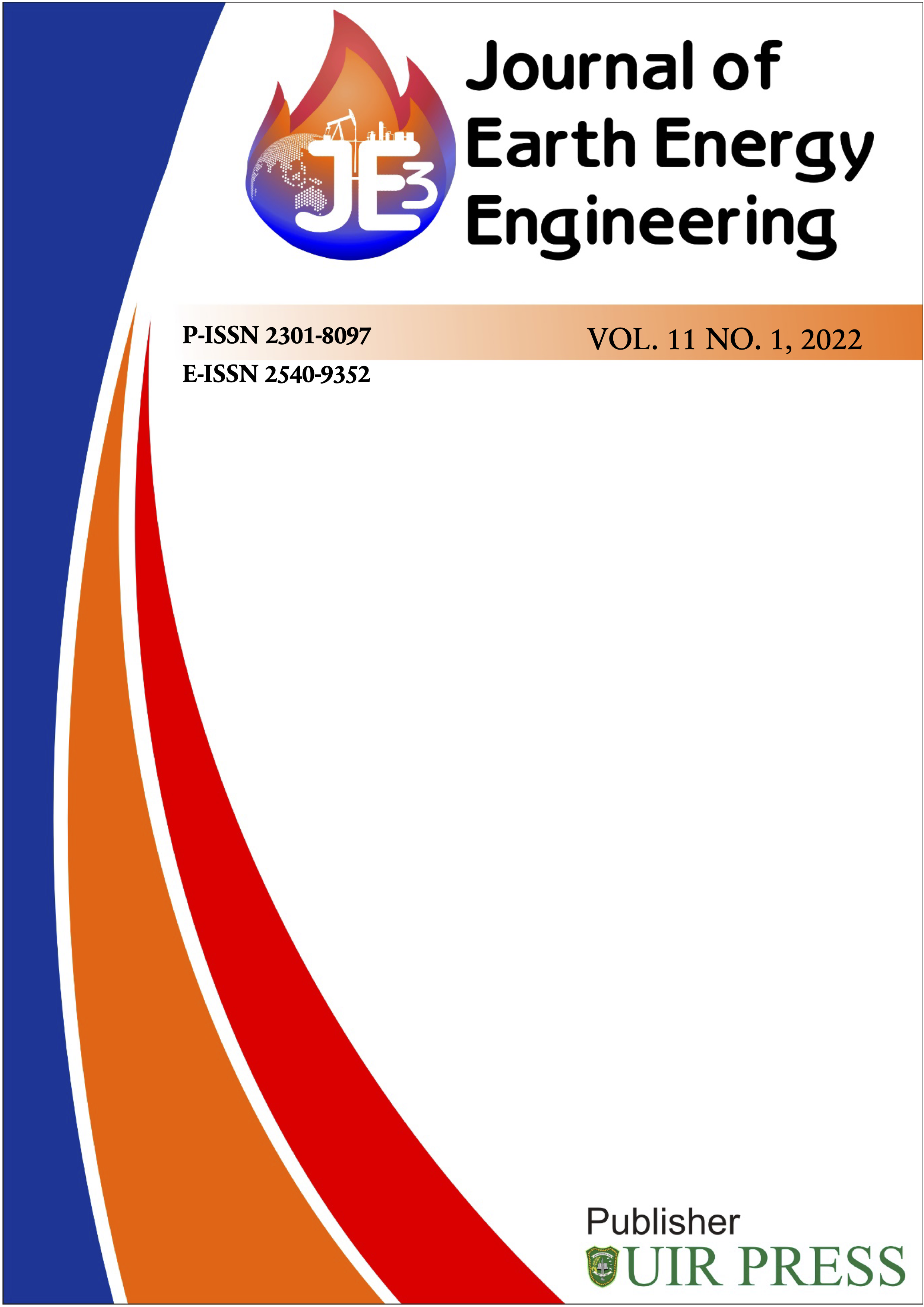Experimental Study of Polymer Injection on Oil Recovery Factor Enhancement Using Homogenous and Heterogenous Micromodel Porous Media
Abstract
Polymer injection is one method of chemical enhanced oil recovery, which increase oil recovery by improving mobility when viscous fingering occurred in waterflooding operation. The result of polymer injection is better sweep efficiency, which is presented by more even distribution of the injected fluid. However, in common laboratory evaluation for polymer injection testing, it was no visual observation that presents directly for the fluiddistribution. This experimental study was carried out to visually observe the polymer injection mechanism to displace oil by micromodel as porous media. The micromodel used in this study is transparent acrylic material which was etched by laser engraving technology to create grains that resemble reservoir rocks. The micromodel was saturated by brine water and light oil respectively as initial reservoir fluids. Then, the water was injected as waterflooding operation to displace oil in a micromodel. Hydrolyzed Polyacrylamide (HPAM) polymer with various concentrations were injected into the micromodel as the last scenario. Through this experiment, the movement and distribution of fluids in chemical enhanced oil recovery especiallypolymer injection was able to be recorded for further analysis. Observation for each scenario was done by Digital Image Analysis (DIA). The micromodel flooding results showed that the higher concentration of polymer would give higher oil recovery. The front stability and good distribution of polymer will result in better sweep efficiency, then higher oil recovery will be achieved. This experiment gives result visually how polymer enhance oil recovery. This experiment is expected to be leading innovation for Enhanced Oil Recovery (EOR) laboratory studies in Indonesia
Full text article
References
Aadland, R. C., Akarri, S., Heggset, E. B., Syverud, K., & Torsæter, O. (2020). A core flood and microfluidics investigation of nanocellulose as a chemical additive to water flooding for EOR. Nanomaterials, 10(7), 1296.
Barati, N. (2011). Study of polymer flooding performance in the presence of nanoparticles. Master Thesis, Petroleum University of Technology.
Bou-Mikael, S. A. (2012). Design and optimization of 2.5 dimension porous media micromodel for nanosensor flow experiments.
Buchgraber, M. (2008). An Enhanced Oil Recovery Micromodel Study with Associative and Conventional Polymers (Issue September). University of Leoben.
Chang, H. L. (1978). Polymer flooding technology yesterday, today, and tomorrow. Journal of Petroleum Technology, 30(08), 1113–1128.
Chatenever, A., & Calhoun, J. C. (1952). Visual examinations of fluid behavior in porous media-part i. Journal of Petroleum Technology, 4(06), 149–156.
Clampitt, R. L., & Reid, T. B. (1975). An Economic Polymerflood in the North Burbank Unit, Osage County, Oklahoma. Fall Meeting of the Society of Petroleum Engineers of AIME.
Danesh, A., Peden, J. M., Krinis, D., & Henderson, G. D. (1987). Pore level visual investigation of oil recovery by solution gas drive and gas injection. SPE Annual Technical Conference and Exhibition.
Hakiki, F., Aditya, A., Ulitha, D. T., Shidqi, M., Adi, W. S., Wibowo, K. H., & Barus, M. (2017). Well and inflow performance relationship for heavy oil reservoir under heating treatment.
Hosseini, S. J., & Foroozesh, J. (2019). Experimental study of polymer injection enhanced oil recovery in homogeneous and heterogeneous porous media using glass-type micromodels. Journal of Petroleum Exploration and Production Technology, 9(1), 627–637.
Javadpour, F., & Fisher, D. (2008). Nanotechnology-based micromodels and new image analysis to study transport in porous media. Journal of Canadian Petroleum Technology, 47(02).
Jenkins, A. D. (2004). Contemporary polymer chemistry . HR Allcock, FW Lampe and JE Mark. Pearson Education, Inc (Pearson/Prentice Hall), Upper Saddle River, NJ, USA, 2003. ISBN 0‐13‐065056‐0 pp xviii+ 814. Polymer International, 53(9), 1395.
Karadimitriou, N. K., & Hassanizadeh, S. M. (2012). A review of micromodels and their use in two-phase flow studies. Vadose Zone Journal, 11(3).
Kenzhekhanov, S. (2016). Chemical EOR process visualization using NOA81 micromodels. Colorado School of Mines.
Lozanski, W. R., & Martin, I. (1970). Taber South-Canada’s first polymer flood. Journal of Canadian Petroleum Technology, 9(02).
Manrique, E. J., Muci, V. E., & Gurfinkel, M. E. (2007). EOR field experiences in carbonate reservoirs in the United States. SPE Reservoir Evaluation & Engineering, 10(06), 667–686.
Needham, R. B., & Doe, P. H. (1987). Polymer flooding review. Journal of Petroleum Technology, 39(12), 1503–1507.
Rowalt, R. J. (1973). A case history of polymer waterflooding brelum field unit. Fall Meeting of the Society of Petroleum Engineers of AIME.
Shaw, R. A., & Stright, D. H. (1977). Performance of TheTaber South Polymer Flood. Journal of Canadian Petroleum Technology, 16(01).
Sheng, J. J. (2013). Polymer flooding—fundamentals and field cases. In Enhanced oil recovery field case studies (pp. 63–82). Elsevier.
Sheng, J. J., Leonhardt, B., & Azri, N. (2015). Status of polymer-flooding technology. Journal of Canadian Petroleum Technology, 54(02), 116–126.
Sorbie, K. S. (1991). Polymer-improved oil recovery, 115 glasgow. Scotland: Blackie & Son, 126–163.
Sugar, A., Serag, M. F., Torrealba, V. A., Buttner, U., Habuchi, S., & Hoteit, H. (2020). Visualization of polymer retention mechanisms in porous media using microfluidics. SPE Europec.
Sugar, A., Torrealba, V., Buttner, U., & Hoteit, H. (2020). Assessment of polymer-induced formation damage using microfluidics. SPE Annual Technical Conference and Exhibition.
Yang, F., Wang, D., Wu, W., Wu, J., Liu, W., Kan, C., & Chen, Q. (2006). A pilot test of high-concentration polymer flooding to further enhance oil recovery. SPE/DOE Symposium on Improved Oil Recovery.
Authors
This is an open access journal which means that all content is freely available without charge to the user or his/her institution. The copyright in the text of individual articles (including research articles, opinion articles, and abstracts) is the property of their respective authors, subject to a Creative Commons CC-BY-SA licence granted to all others. JEEE allows the author(s) to hold the copyright without restrictions and allows the author to retain publishing rights without restrictions.




